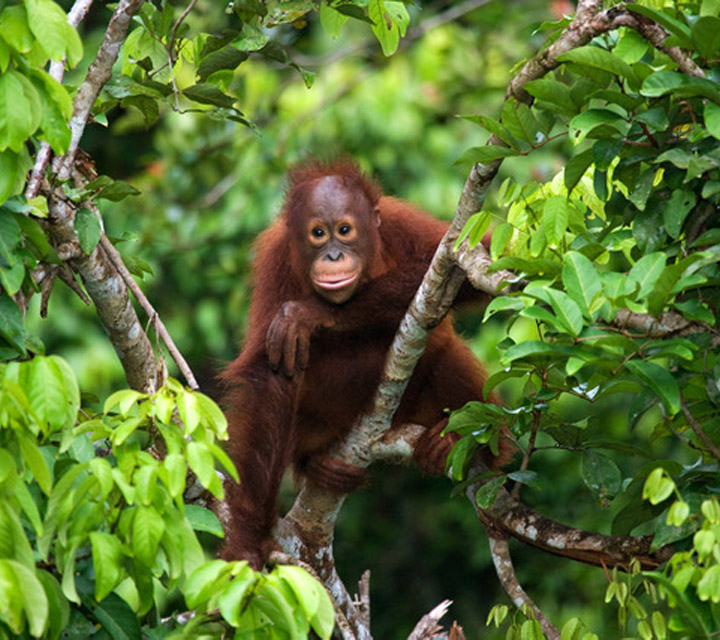
This report provide the necessary information to satisfy the biodiversity sections of CCBA application.
Report by the Orangutan Tropical Peatland Project (OuTrop) to help satisfy the checkpoints related to biodiversity and facilitate the acquisition of Approved/Gold Standard status for the proposed Forest Carbon Project in Katingan Regency.
Borneo is one of the world’s most biodiverse regions, and peat-swamp forests harbour a significant proportion of this biodiversity. Due to their very high carbon content, great potential exists for REDD projects in peat-swamp forests, which can potentially provide much-needed revenue for conserving these forest’s unique biodiversity.
PT. Rimba Makmur Utama / Starling Resources’ proposed REDD concession area covers 227,260 ha of mostly forested peat-swamp forest in the Katingan and Kotawaringan Timur Districts, Central Kalimantan, Indonesia. During February-April 2010, we assessed the biodiversity present in the forest, abundance of three endangered and high-profile primate species – orang-utans, gibbons and proboscis monkeys – and threats facing this biodiversity in the proposed concession area. This revealed that Katingan is home to 68 mammal (6 Endangered/EN, 14 Vulnerable/VU and 21 protected under Indonesian law), 159 bird (1 Critically Endangered, 1 EN, 5 VU and 36 protected), 44 reptile (3 EN, 3 VU, 4 protected), 7 amphibian and 110 fish species (note that these latter three lists will be incomplete). Preliminary estimates indicate a total of 3,619 orang-utans, 9,786 gibbons and at least 540 proboscis monkeys. These populations all represent over 5% of the remaining global population of these species, classifying them as High Conservation Value (HCV) species in the area and classifying this forest as a Key Biodiversity Area (KBA). In line with the precautionary principle and considering the large size of the proposed concession area, the remaining Critically Endangered and Endangered species found in the area, in particular the white-shouldered ibis and Storm’s stork, should also be considered potential HCV species.
This biodiversity in Katingan is currently facing a variety of threats, however, which need to be countered if the conservation of biodiversity and HCVs in the area is to be successful. The most important threats to the area’s biodiversity and HCVs are peat drainage and subsequent fire, illegal logging, gold mining, potential conversion to oil palm plantations and coal concessions, and hunting. In relation to this, we identify 14 active drivers of biodiversity loss in Katingan and six agents of biodiversity loss.
Without the project, the most likely land-use scenario is that illegal logging, hunting, peat degradation and other harmful activities will continue, and that risk of fire and encroachment from gold mines and oil palm will increase. This will lead to severe negative impacts on the area’s biodiversity and declines in the population size of orang-utans, gibbons, proboscis monkeys, and other HCVs. The majority of the project’s activities will be directly beneficial to biodiversity and HCVs in the area; the remainder will be neutral or have indirect positive impacts.
We recommend thirteen biodiversity objectives be adopted by the project proponents. Further, we propose a preliminary monitoring programme to demonstrate whether the Project has achieved the stated biodiversity objectives and has had net positive biodiversity benefits. A full monitoring programme will be submitted within a year of acceptance to CCBA standards. This monitoring programme will focus on the area’s HCV primates – orang-utans, gibbons and proboscis monkeys – in addition to other potential HCV species, flora and habitat condition, and other indicators of ecosystem health that are currently under consideration.
Based on these results, it is clear that Katingan is a crucial area for biodiversity conservation, particularly for orang-utans, gibbons and proboscis monkeys. It is also clear that this biodiversity faces a number of threats, that the project activities will benefit biodiversity conservation and that these activities are very unlikely to occur in the absence of the project. Thus, we conclude that the implementation of this project is important for biodiversity conservation, both in Borneo and globally.
Buy carbon credits from Katingan
Climate change is a global challenge that requires global action. We can help you meet your commitments to deliver a brighter future.


